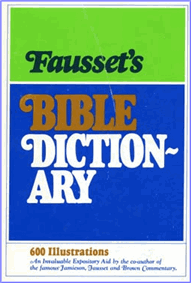Fausset's Bible Dictionary
A B C D E F G H I J K L M N O P Q R S T U V W X Y Z
Sun
Genesis 1:14 translated "let there be luminaries," literally, "light bearers". Genesis only tells what the sun, moon, and stars are in relation to the earth. When the mists were dispelled, and the seas confined within bounds, the heavenly bodies assumed their natural functions, marking days and nights, seasons and years, and God appoints the sun to rule the day and the moon the night. "Let them be for signs," as eclipses, portents of extraordinary events (Matthew 2:2; Luke 21:25) and divine judgments (Joel 2:30; Jeremiah 10:2; Matthew 24:29), and indicating the four quarters of the heavens (Psalm 50:1) and also the changes in the weather; "and for seasons, days, and years." The sun regulated the length of the Israelite year by the recurrence of Pentecost at a fixed agricultural season, namely, when the grain was ripe.
The person facing the rising sun faced the E.; so "before," "forward," meant the E.; "behind," "backward," meant the W.; "on the left hand" meant the N."; "on the right" the S. (Job 23:8-9). Shemesh, "sun," expresses the stupor produced on the beholder by his overwhelming brilliancy; chammah and cherec are poetical names implying his "heat". Sun worship was the earliest idolatry (Job 31:26-27); Ra was "the sun god in Egypt"; On was "the city of the sun worship" (Jeremiah 43:13; Hebrew), Bethshemesh "house of the sun," Greek Heliopolis. Joshua's causing the sun to stand still phenomenally virtually proclaimed his God Jehovah to be Lord of the sun and all creation, in the face of pagandom. The valley of Ajalon is still called wady el Mikteleh, "the valley of slaughter." The Phoenician Baal; the Ammonite Moloch and Milcom; the Syrian Hadad; latterly the Persian Mithras (Zoroaster previously had reformed the worship).
The "sun images" were called in Hebrew chammanim (Leviticus 26:30; margin 2 Chronicles 14:5; 2 Chronicles 34:4), stone statues to "solar Baal" or Baal Haman in Carthaginian inscriptions. The temple at Baalbek was dedicated to the worship of the sun. Manasseh introduced direct sun worship (2 Kings 21:3; 2 Kings 21:5). Josiah destroyed by fire (the very element which was worshipped) the chariots, and removed the horses consecrated to the sun (2 Kings 23:5; 2 Kings 23:11-12). The housetop was the place of sun altars and incense burning (Zephaniah 1:5).
Worship was directed to the rising sun (Ezekiel 8:16-17); they used to hold a bunch of "tamarisk branches" (barsom) to their nose at daybreak, while singing hymns to the rising sun (Strabo, 1:15, section 733). The horses sacred to the sun, and used in processions to meet the rising sun, were kept at the entering in of the house of Jehovah in the portico (as Gesenius explains parwarim in 2 Kings 23:11, not "suburbs") at the western side of the outer temple court. An insult to the only true God, in His own house! Spiritually, God's law is the sun (Psalm 19:7). He is a Sun to cheer; and "the Sun of righteousness," from whom we receive all righteousness, by imputation for justification, and by impartation for sanctification (Malachi 4:2; Revelation 1:16).
Bibliography Information
Fausset, Andrew Robert M.A., D.D., "Definition for 'sun' Fausset's Bible Dictionary".
bible-history.com - Fausset's; 1878.
Copyright Information
© Fausset's Bible Dictionary
Fausset's Bible Dictionary Home
Bible History Online Home
Bible Encyclopedia (ISBE)
Online Bible (KJV)
Naves Topical Bible
Smith's Bible Dictionary
Easton's Bible Dictionary
Schaff's Bible Dictionary
Fausset's Bible Dictionary
Matthew Henry Bible Commentary
Hitchcock's Bible Dictionary

Dr. A.R. Fausset
Popular and Trending:
Meaning and definition of fasting, what is fasting in the bible, fasting definition, why should I fast, the power of prayer and fasting, Location of Galilee, where was galilee in the bible?, fasting definition, Galilee region, cities of Galilee, Sea of Galilee, Definition of biblical fire, what is fire in the bible?, fire and brimstone, fire meaning, baking bread with fire, Definition of the biblical firmament in Genesis, what is the firmament in the bible?, was the firmament the third heaven, firmament meaning, did the firmament bring the flood of Noah?.
